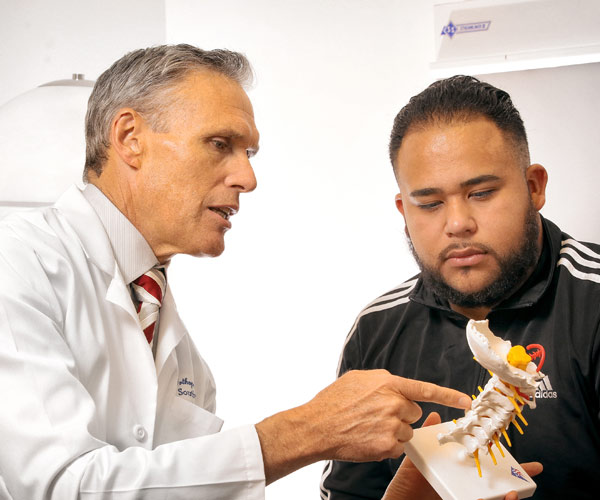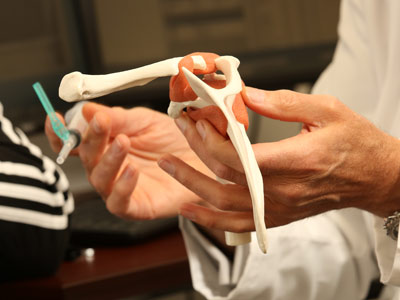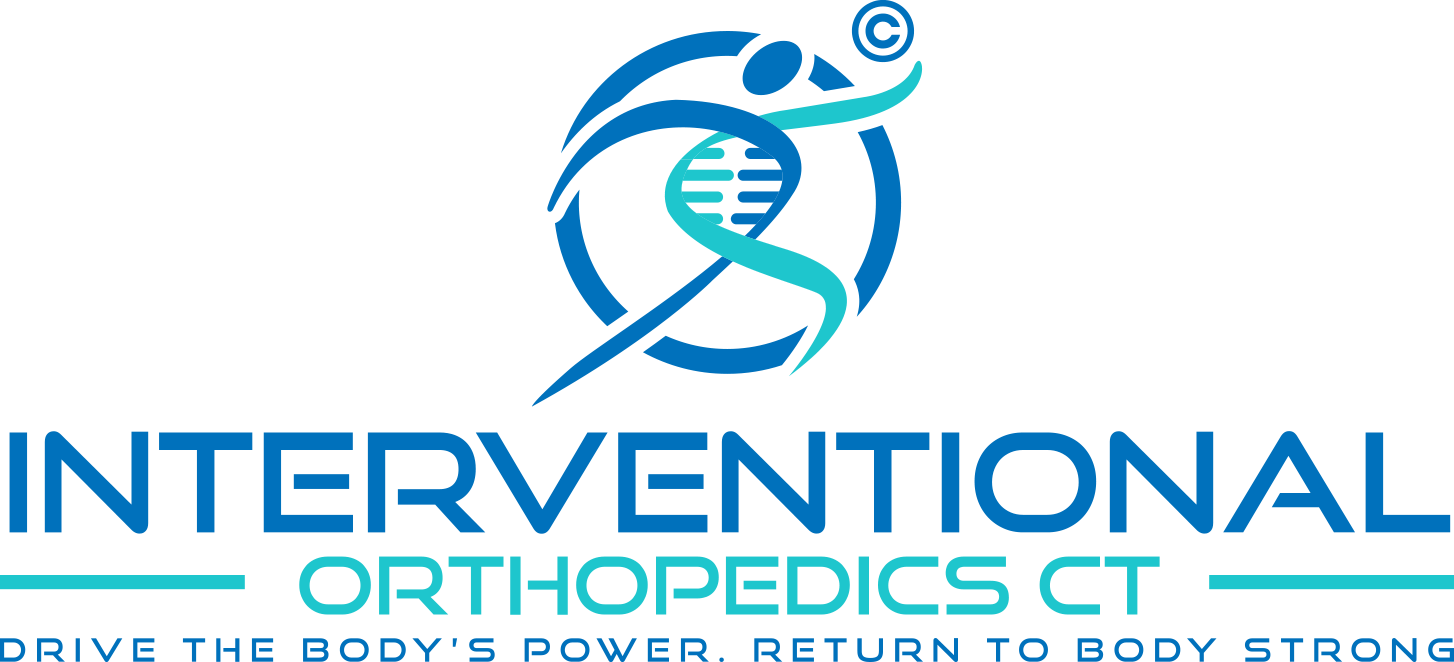Shoulder Pain
About Shoulder Pain
The shoulder is a complex joint with an amazing range of motion through which run all the nerves and blood vessels of the upper extremity. It is one of the more vulnerable joints of the body to traumatic or repetitive strain injury. Like any joint, it is subject to degenerative change from ‘wear and tear’ in the form of osteoarthritis. This type of shoulder pain increases with age and is accelerated by a history of traumatic injury or after shoulder surgery. The joint is held together with ligaments connecting the long bone of the arm to your shoulder blade. Important tendons of the arm and shoulder cross over it. The great range of motion of the healthy joint can, through repetitive strain or trauma, cause injury to these ligaments and tendons as well as to the shoulder cartilage resulting in pain and loss of range of motion.
Shoulder pain requires a careful diagnosis and can be confusing. Symptoms of pain and discomfort that are experienced as coming from the shoulder may actually be a ‘referred’ pain coming from another source such as the neck. Shoulder pain that actually comes from the joint typically worsens with activity or movement involving the shoulder. Shoulder pain that is referred from another source does not worsen with shoulder movement.

Symptoms of Shoulder Pain
Depending on the cause of your knee pain you might experience one or more symptoms that include stiffness, swelling, redness with a warm sensation to the touch, weakness and instability, “popping”, “grinding” or “crunching” sounds and a loss of the normal range of motion with an inability to fully straighten your knee.
Causes of Shoulder Pain
Shoulder pain results from sudden trauma, repetitive strain or over-use injury, or simply degenerative wear and tear with age. Trauma to the shoulder from a fall onto an outstretched arm or sudden blow to the shoulder can result in dislocation or separation of the shoulder. In a dislocation, the ball joint of the shoulder is forced out of the socket. This can cause damage to the cartilage ‘cup’ of the socket known as the labrum as well as bony injury on either side of the joint. A shoulder separation involves the small joint between the clavicle and the shoulder blade. Both injuries usually involve ligamentous injuries and, possibly, bone fractures. Tendonitis refers to inflammation of the tendons that cross the shoulder joint and is caused by irritation of the tendons usually from repetitive shoulder activity. Weakness in the shoulder muscles can increase instability in the shoulder which can result in tendonitis. The most commonly affected tendons in the shoulder are the four rotator cuff tendons and one of the biceps tendons. The rotator cuff is made up of four small muscles and their tendons that cover the head of your upper arm bone and keep the shoulder located in the socket. Your rotator cuff helps provide shoulder motion and stability. The rotator cuff tendons are sensitive to repetitive reaching activities especially reaching overhead and throwing activities both of which can cause rotator cuff syndrome otherwise known as ‘impingement syndrome’. Bursitis occurs when the small fluid filled sacs -“bursae”-that reduce friction and act as cushions, become inflamed. Sometimes, excessive use of the shoulder for work or sports that include throwing activities leads to inflammation and swelling of the bursa between the rotator cuff and a part of the shoulder blade. Bursitis often occurs along with rotator cuff tendonitis and is quite painful even making routine daily activities like combing your hair and brushing your teeth painful and difficult. Tendon tears can result from injury or degenerative changes that occur with age, or even excessive long term overuse. The rotator cuff and biceps tendon injuries are among the most common of these injuries. Shoulder instability can also cause shoulder pain. Shoulder instability implies there is more than normal motion in the shoulder joint and is often the result of shoulder dislocation that injures ligaments or joint capsule. Arthritis begins in the shoulder cartilage and progresses to underlying bone. It is the result of age and “wear and tear”. Shoulder osteoarthritis can cause shoulder pain, swelling and stiffness. Shoulder osteoarthritis may be related to sports or work injuries which accelerate degeneration in the joint. Shoulder impingement occurs when the top of the shoulder blade puts pressure on the underlying soft tissues as the arm is lifted away from your body. Impingement may actually result in bursitis or tendonitis and can result in a tear of the rotator cuff.
Non-Surgical Treatment for Shoulder Pain
Physical therapy is the mainstay of conservative treatment of bursitis, tendonitis, and traumatic shoulder injury. Therapeutic exercise and stretching can improve strength, reduce instability and restore normal, pain-free range of motion. Activity modification and avoiding activities /sports that increase pain are important initially. Oral medications such as Tylenol and non-steroidal anti-inflammatories along with topical pain creams can help to control symptoms and allow participation in therapy. When this is not possible or if therapy is not helping, traditional shoulder injections with cortisone may help to control painful inflammation and temporarily restore somewhat normal function. Unfortunately, in the long run, steroids such as cortisone contribute to degenerative processes within the joint that result in the progression of osteoarthritis.
To learn more and get help for shoulder pain please Schedule an Appointment with Regenerative Orthopedic & Sports Medicine Specialist Daniel Southern, M.D. in Danbury or Wilton in Fairfield County Connecticut by calling 203-456-5717.


Surgical Treatment for Knee Pain
While about 90 percent of patients with shoulder pain will respond to simple treatment methods such as altering activities, rest, exercise, and medication, in the event that non- surgical treatment of your shoulder pain does not allow you to return to your typical daily activities, work, or sports and athletic activities in a comfortable manner, surgery might be an option.
Arthroscopy – Arthroscopy is a procedure that uses a lighted scope and very small surgical instruments, including a fiber optic camera, to diagnose and repair shoulder problems through several tiny incisions around your shoulder. Arthroscopy is used to cut away damaged tissue and reconnect severed ligaments and tendons or reattach cartilage that is separating from bone. When arthroscopy is not possible, as in extensive traumatic injuries, an ‘open’ procedure may be necessary wherein a deep incision is made to expose the entire shoulder joint. This will result in longer recovery compared with an arthroscopic procedure.
Total Shoulder Replacement (Arthroplasty)-Total Shoulder Arthroplasty allows your surgeon to replace both the joint “ball and socket” with an artificial joint made of metal alloys, high-grade plastics and polymers. It usually is done when all other treatment options have failed to provide adequate pain relief and mobility, as joint replacement often has a long recovery and rehabilitation period.
To learn more and get help for shoulder pain please Schedule an Appointment with Regenerative Orthopedic & Sports Medicine Specialist Daniel Southern, M.D. in Danbury or Wilton in Fairfield County Connecticut by calling 203-456-5717.
Regenerative Orthopedic Medicine Treatment for Shoulder Pain
Regenerative procedures provide non-surgical treatment options for those suffering from pain related to osteoarthritis, joint injuries, spine pain, overuse conditions, and common sports injuries. These medical procedures are performed by highly-skilled doctors and are used to help reduce pain and improve function. They may help improve your quality of life, return to the activities you enjoy, and avoid the need for surgery or joint replacement*.
*DISCLAIMER: Like all medical procedures, regenerative procedures have a success and failure rate. Patient reviews and testimonials on this site should not be interpreted as a statement on the effectiveness of our treatments for anyone else.

